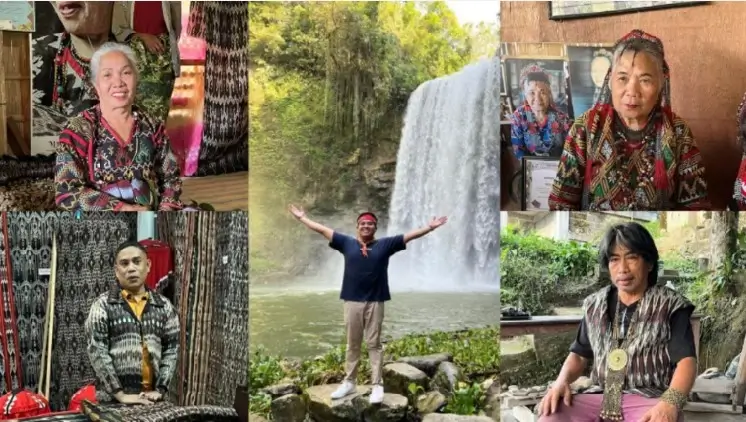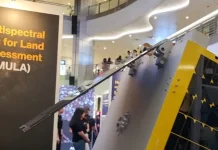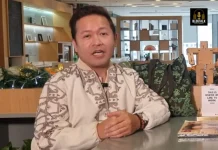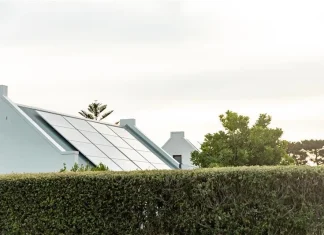
If I could describe Day 4 in one word, it would be adventurous.
And rightly so—this day was packed with cultural immersions, a scenic cruise, and real adventures on the ground… or should I say, in the air.
Thanks to the five-day Marketing Enhancement Program (MEP) organized by the Tourism Promotions Board Philippines (TPB), an attached agency of the Department of Tourism, I got to experience it all.
Now I have a story worth telling—and one I’ll surely remember from time to time.
Welcome to our Day 4, concentrating on exploring the Land of Dream Weavers – Lake Sebu, South Cotabato.
Check out all the spots we explored from Davao to Soccsksargen here:
Day 1: 24 Hours in Davao City: A Day of Culture, Cuisine, and Scenic Views | Atom Pornel
Day 3: Cultural Threads: Tracing Traditions from Davao del Sur to South Cotabato | Atom Pornel
Kesesonom Weaving Center
After our breakfast, we immediately headed to our destinations for the day.
Our first stop was the Kesesonom Weaving Center in Sitio Tablo, Brgy. Lamdalag.
The center is managed by Barbara Ofong, the second T’boli master weaver to be recognized as a National Living Treasure.
In 2023, she was honored by the National Commission for Culture and the Arts as a Manlilikha ng Bayan for her skill and contribution to the preservation and promotion of T’nalak weaving.
Even though she isn’t fluent in speaking Tagalog, the immersion experience—along with the help of her interpreter, Sir Michael Yambok—became a way for us to better understand how their proud local textile is made.
Beyond that, we had the chance to see and touch Bo’i Barbara’s masterpieces. Her works are refined, clearly crafted with time, care, and heart.
It was at the weaving center where I first witnessed the actual process of T’nalak weaving up close. Goosebumps!
What I used to only see in documentaries and vlogs, I finally saw in person. Truly a sight to behold!
Before we left the weaving center, we were treated to a dance performance by young T’boli children.
T’boli Community Library and Culture Hub
After a brief immersion at the Kesesonom Weaving Center, our delegation made its way to the T’boli Community Library and Culture Hub, located in Upper Kawig in Brgy. Poblacion.
We were warmly welcomed with a simple yet hearty merienda—boiled saging na saba and kamote—a much-needed break in our already eventful morning.
Established and inaugurated in 2021 by teacher and cultural worker Michael Angelo Yambook, the library and culture hub was thoughtfully built using concrete, wood, and bamboo, inspired by the design of a traditional T’boli house.
Today, the two-story building is home to thousands of books generously donated by supporters from around the world.
The visit also served as a chance for TPB to donate a printer to support the library and culture hub’s daily operations.
Now, the library is open to all generous hearts who wish to contribute to its growing collection of books and school supplies for T’boli children.
Those interested in supporting the community library may reach out via email at yhummay2011@gmail.com.
Lang Dulay T’nalak Weaving Center
From the community library and culture hub, we made our way to another weaving center, this time named after the late Manlilikha ng Bayan awardee and T’nalak master weaver, Lang Dulay.
Located in Sitio T’bong, Brgy. Lamdalag, the center now stands as a concrete structure—quite different from the humble kubo I used to see in documentaries. Still, its design remains faithful to the traditional T’boli home.
The ground floor serves as a shop, while the second floor is dedicated to the weaving area—where the magic of T’nalak creation comes to life.
T’boli children welcomed us with a traditional dance as a heartfelt gesture of their warm reception. It was truly touching to witness how the community continues to preserve its unique intangible culture by passing it on to the younger generation.
Then came the introduction of master weaver Sebulan Dulay, who now leads the weaving center.
Then followed the introduction of master weaver Sebulan Dulay, who now heads the weaving center.
Based on T’boli traditions and practices for centuries, only women are allowed to weave T’nalak. A weaver passes down her inherited knowledge to her daughter, who will then teach it to her child in the future. In this way, their art and tradition are kept alive and carried forward through generations.
But this was not the case for the late Lang Dulay (1928–2015), who was not blessed with a daughter. Because of this, she passed on her weaving knowledge to her sister-in-law, Sebulan Dulay, who had served as her assistant and apprentice.
When Lang Dulay passed away, Sebulan was entrusted with the responsibility of continuing the T’nalak weaving tradition in their community.
They also showed the meticulous process of making T’nalak—from gathering abaca, collecting its strands, drying, coloring, and weaving, to burnishing the textile with a cowrie shell.
It was just a short crash course, but one I highly recommend—especially for those who want to learn more about T’boli culture and T’nalak weaving.
100 T’nalak Gallery
This was definitely a T’nalak-overload kind of day — fun, insightful, and unforgettable. After visiting two T’nalak weaving centers, we even had a short detour at the 100 T’nalak Gallery, located near Lang Dulay’s.
The owner, Sir Reden Ulo, warmly welcomed us into his gallery and showed us his wide collection of Lake Sebu’s precious textiles. They are all stunning!
“This is for the whole community,” he said during our tour, explaining the purpose behind creating a gallery for his stunning collection.
According to him, this allows the local community to continue seeing T’nalak masterpieces from different generations of weavers. It also gives tourists and visitors the opportunity to appreciate the textiles when they visit Lake Sebu.
“As you see, the T’nalak pieces are usually bought by buyers here in Lake Sebu. But I’m trying to save some… at least they can still sell, but something is left behind for the community. That’s the goal of this [T’nalak Gallery],” he explained.
That makes perfect sense.
Imagine—if owning a single piece of T’nalak is already a treasure, then having hundreds is nothing short of a cultural legacy.
For those who would love to see his collection, this is definitely worth including in your tour itinerary. I can say this was one of the highlights of my visit to South Cotabato.
Lake Cruise and Lunch at Lake Sebu
With all the places we visited that morning, I didn’t even realize it was already lunchtime. Time truly flies when your mind is immersed in something you’re passionate about.
So for lunch, we headed to Punta Isla, a lake resort in Lake Sebu that offers a cruise experience. Lakas maka-sosyal!
I never imagined I’d get to experience something like this in my life: a lake cruise with lunch. And really, who am I to say no to an experience like that?
I can definitely say that this trip was a feast for the senses. Why? Aside from the beautiful and relaxing views, the food they served was absolutely delicious.
It was truly a delight—not just for the eyes, but for the stomach and taste buds as well.
And since this was a lake cruise, there was a cultural show as well.
Our food servers simply changed into traditional T’boli attire, and voilà—an instant performance!
So, for anyone planning a trip to Lake Sebu, make sure to include their lake cruise in your itinerary. It’s absolutely worth it—and truly one of a kind. Sulit!
Cooperative of Women in Health and Development (COWHED)
To walk off our meal and wait for the rain to ease, we headed to COWHED. It was just a short walk from Punta Isla and right next to the resort where we were staying.
COWHED stands for Cooperative of Women in Health and Development. It’s where T’boli artisans sell their products—woven fabrics, traditional clothing, beadwork, and many more.
The moment we stepped inside, it felt like walking into a museum. Yes—another museum moment after our immersions at the Kesesonom Weaving Center, the Lang Dulay Weaving Center, and the 100 T’nalak Gallery.
At that point, my mind could only say one thing: Wow, grabe!
(Fun fact again: COWHED was one of the places visited by Catriona Gray when she shot video materials for the Miss Universe competition back in 2018.)
Thanks to COWHED, T’boli women—especially mothers—are given opportunities to earn and support their families.
So for those looking for souvenirs, pasalubongs, and authentic T’boli crafts, this is the best place to be.
Seven Falls Zipline (The Highest in Southeast Asia)
After our short visit to COWHED — which happened to be just behind the resort where we were staying — we went to the famous Seven Falls of Lake Sebu to try the zipline.
Upon arrival, I couldn’t even begin to explain how beautiful the place was. It felt both familiar and new, and I had a hard time finding the right words to describe it. But one thing was certain — the lush vegetation was absolutely stunning. I couldn’t help but feel giddy and excited when I saw one of the massive waterfalls — one of the seven — just within reach in the distance.
(Another fun fact: Catriona Gray and her team filmed here for her audio and video materials during the Miss Universe 2018 competition.)
After taking a few snaps near the waterfall, it was time to face our fears as we lined up for the zipline experience. According to our tour guides, it’s the highest in Southeast Asia — and with that one fact alone, sinong hindi kakabahan? Hahaha!
I was fifth in line. But since those ahead of me weren’t quite ready yet, they asked me to go first instead. It was a mix of excitement and anxiety. The pressure was real!
Good thing Miko, one of the vloggers who joined the trip, accompanied me. While I was trying to calm myself, I could totally tell he was just as nervous — it showed all over his face! Haha!
To cut the story short — we conquered our nerves. Not just once, but twice! Sumakses, kumbaga! It was nerve-wracking at first — we ended up screaming our lungs out. But halfway through, we calmed down and just took in the breathtaking view below.
On the way back — still via zipline — we rode in total silence, quietly scanning the area to spot the other waterfalls.
I’d say that experience was both liberating and totally worth it! Plus, I got to see four out of the seven waterfalls in the area. It’s definitely something I’d love to do again — and I highly recommend it to anyone who’s brave enough and up for an adventure.
Brass and Soul: The Artistry of Bundos Fara
Our adventure didn’t end there. Just a few minutes’ drive within the area is the workshop of master metalworker and National Living Treasure Bundos Fara. It’s located right along the highway and is accessible to anyone who wishes to visit.
I had the privilege of interviewing this proud T’boli artisan, who has been passionate about his craft since the age of 8. (He turned 60 last March 21.)
Sabi n’ya, his designs were normally given by his customers, but he also has traditional designs of his own.
“Depende sa tao. Halimbawa sa akin, kahit anong klaseng disenyo—kung anong gusto ko, ’yon ang gagawin ko. Galing sa isip ko (It depends on the person. For me, any kind of design—whatever I want, that’s what I create. It all comes from my mind),” he revealed.
A master of “Temwel,” the traditional T’boli art of brass casting, Bundos Fara has dedicated nearly his entire life to his craft. In 2023, he was officially recognized as a Manlilikha ng Bayan (National Living Treasure), an honor that includes financial assistance to help him sustain and pass on his extraordinary artistry.
“Malaking tulong [ang recognition]. Noong pagka-start ko-ako bilang third generation-medyo mahirap kung maghanap ng materials, mga financer, kasi walang suporta. Ngayon, kahit papaano, mas maganda (The recognition is a big help. When I was starting—as the third generation in my family—it was difficult to find materials and financial support because there was no help. Now, things are better),” he shared.
Because of this, he expressed his deep gratitude for the support he’s now receiving.
“Maraming salamat sa tulong ng Tourism, sa DTI, taga-province, at taga-NCCA. Maraming salamat sa tulong nila sa akin (I’m truly thankful for the help from the Department of Tourism, DTI, the provincial government, and the NCCA. Their support means a lot to me),” Fara added.
A father of seven, he proudly shared that all four of his sons have now learned the art of brass casting.
“Lahat ’yong apat marurunong (All four of them know the craft),” he said with pride.
One of his sons, Jefferson, shared that students now visit their workshop, as brass casting has been included in the curriculum of a nearby school
“Meron ng subject na brass casting. Pumupunta po sila dito nagre-research kung ano ba ’yong brass casting (There’s already a subject on brass casting. They come here to do research and learn what it’s all about),” Jefferson said.
This development is a promising sign that the T’boli tradition of brass casting will continue to thrive—carried forward by younger generations eager to learn and preserve the craft.
I also asked where they get their metallic materials.
“Sa junk shop (From junk shops),” he simply replied.
Recycling old metal into intricate art pieces, the Fara family not only preserves a cultural tradition but also gives discarded materials a new life—transforming scrap into heritage.
We proceeded to have a late merienda—pancit and fruit shakes—at a nearby restaurant. I had left my phone charging inside the van, so I wasn’t able to take photos or videos. Still, it was a meaningful moment as we shared stories about our day—especially the zipline adventure—and reflected on the fact that it was our last full day in Lake Sebu.
By 7 PM, we were back at the hotel restaurant for dinner. The standout? A dessert unlike anything I’d tried before: blue ternatea ice cream with crispy tilapia flakes on top. It was rich, subtly floral, and unexpectedly good.
Judging by everyone’s reaction, I wasn’t the only one pleasantly surprised. Two thumbs up for this usual ice cream dessert.
Stay tuned for Day 5 of our CBT adventure, featuring last-minute ganaps in Lake Sebu and our journey to the not-so-nearby town of Tupi, as well as General Santos City. Catch it soon here on GoodNewsPilipinas.com!
Join our vibrant Good News Pilipinas community, where we celebrate the achievements of the Philippines and Filipinos worldwide! As the Philippines’ No. 1 Website for Good News and proud winners of the Gold Anvil Award and Lasallian Scholarum Award, we invite you to connect, engage, and share your inspiring stories with us. Together, let’s shine a spotlight on the stories that make every Filipino proud. Follow us on all platforms through our LinkTree. Let’s spread good news and positivity, one story at a time!










